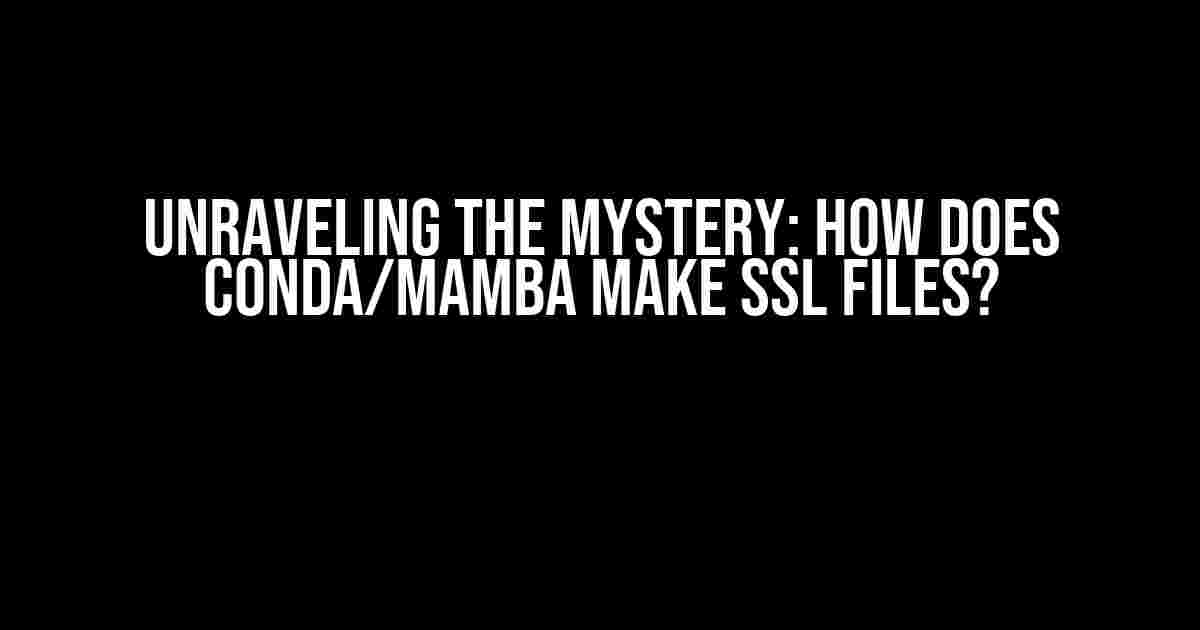As you venture into the world of package management, you may stumble upon the wonders of Conda and Mamba. These popular tools make installing and managing packages a breeze, but have you ever wondered what magic happens behind the scenes when it comes to creating SSL files? Buckle up, folks, and let’s dive into the fascinating realm of SSL certificate creation with Conda and Mamba!
What are SSL files, anyway?
Before we dive into the Conda/Mamba SSL-making process, let’s take a step back and understand what SSL files are. SSL (Secure Sockets Layer) or TLS (Transport Layer Security) certificates are the unsung heroes of the internet, ensuring that data transmitted between your browser and a website remains encrypted and secure. These digital certificates contain crucial information, such as the domain name, organization name, and public key, which helps establish trust between the client and server.
The importance of SSL certificates in Conda/Mamba
In the context of Conda and Mamba, SSL certificates play a vital role in securing package downloads and installations. When you install a package using Conda or Mamba, the package manager needs to connect to the package repository over HTTPS (Hypertext Transfer Protocol Secure). To establish this secure connection, the package manager requires an SSL certificate, which ensures that the package repository’s identity is verified, and the data exchanged is encrypted.
The Conda/Mamba SSL-making process
Now that we’ve covered the basics, let’s delve into the step-by-step process of how Conda and Mamba create SSL files:
- Generating a private key: Conda/Mamba uses the OpenSSL library to generate a private key, typically in the form of a PEM (Privacy Enhanced Mail) file. This private key is used to create the SSL certificate.
- Creating a Certificate Signing Request (CSR): The private key is then used to create a Certificate Signing Request (CSR), which contains the domain name, organization name, and other identifying information. The CSR is sent to a Certificate Authority (CA) for signing.
- Obtaining a signed SSL certificate: The CA verifies the information in the CSR and issues a signed SSL certificate, which is typically in the form of a PEM file.
- Creating a certificate bundle: Conda/Mamba combines the signed SSL certificate with any necessary intermediate certificates and the private key to create a single certificate bundle, often in the form of a single PEM file.
- Configuring the package manager: The certificate bundle is then configured to be used by the package manager, allowing it to establish secure connections with the package repository.
# Example OpenSSL command to generate a private key
openssl genrsa -out private_key.pem 2048
# Example OpenSSL command to create a CSR
openssl req -new -key private_key.pem -out csr.pem -subj "/C=US/ST=State/L=Locality/O=Organization/CN=example.com"
# Example OpenSSL command to obtain a signed SSL certificate
openssl x509 -req -in csr.pem -CA ca.pem -CAkey ca_key.pem -CAcreateserial -out signed_cert.pem -days 365
# Example OpenSSL command to create a certificate bundle
cat signed_cert.pem intermediate_cert.pem > certificate_bundle.pem
Customizing SSL certificate creation with Conda/Mamba
While Conda and Mamba provide a default SSL certificate creation process, you may need to customize it to suit your specific requirements. Here are some common scenarios:
Using a custom Certificate Authority
If you have an internal Certificate Authority or want to use a specific CA, you can configure Conda/Mamba to use a custom CA:
conda config --set ssl_verify true
conda config --set certificate_authority /path/to/custom_ca.pem
Specifying a custom SSL certificate
If you already have an SSL certificate, you can specify it for use with Conda/Mamba:
conda config --set ssl_cert_file /path/to/custom_cert.pem
conda config --set ssl_key_file /path/to/custom_key.pem
Disabling SSL verification
In some cases, you may need to disable SSL verification for specific repositories or hosts. Please note that this is not recommended, as it compromises the security of the package download process:
conda config --set ssl_verify false
| Scenario | Customization | Command |
|---|---|---|
| Using a custom Certificate Authority | Specify the custom CA file | conda config --set certificate_authority /path/to/custom_ca.pem |
| Specifying a custom SSL certificate | Specify the custom cert and key files | conda config --set ssl_cert_file /path/to/custom_cert.pem |
| Disabling SSL verification | Disable SSL verification | conda config --set ssl_verify false |
Best practices for SSL certificate creation with Conda/Mamba
When working with Conda and Mamba, it’s essential to follow best practices for SSL certificate creation to ensure secure package downloads and installations:
- Use a trusted Certificate Authority to sign your SSL certificate.
- Keep your private key secure and do not share it with unauthorized parties.
- Use a strong and unique password for your private key.
- Regularly update and rotate your SSL certificates to maintain security.
- Avoid using self-signed certificates or certificates with weak encryption.
In conclusion, Conda and Mamba’s SSL certificate creation process is an essential aspect of ensuring secure package downloads and installations. By understanding how this process works and customizing it to suit your needs, you can maintain the integrity of your package management workflow. Remember to follow best practices for SSL certificate creation to ensure the security of your package downloads.
Frequently Asked Question
Ever wondered how Conda and Mamba create those mysterious SSL files? Well, wonder no more! Here are the answers to your burning questions:
What’s the magic behind Conda’s SSL file creation?
Conda uses the OpenSSL library to generate SSL certificates and private keys. When you create a new environment or install a package, Conda runs the OpenSSL commands in the background to create the necessary SSL files. This ensures that the packages are downloaded securely from the repository.
How does Mamba fit into the SSL file creation process?
Mamba, being a faster and more efficient package manager, uses the same OpenSSL library as Conda to create SSL files. However, Mamba’s faster execution and parallel downloading capabilities make the SSL file creation process even snappier!
Where do Conda and Mamba store the SSL files?
Conda and Mamba store the SSL files in the `.conda` or `.mamba` directory, respectively, within your user directory. These directories contain the certificates and private keys necessary for secure package downloads.
Can I customize the SSL file creation process in Conda?
Yes, you can! Conda allows you to customize the SSL file creation process by setting environment variables or modifying the `conda.cfg` file. You can specify alternative certificate authorities, private key files, or even disable SSL verification altogether (though we don’t recommend that!)
What if I encounter issues with Conda’s SSL file creation?
Don’t panic! If you encounter issues with SSL file creation, try updating Conda or Mamba to the latest version. You can also try resetting the SSL certificates by running `conda config –set ssl_verify False` followed by `conda config –set ssl_verify True`. If the issue persists, feel free to ask the Conda community for help!




